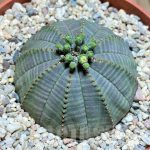Lithops and their close relatives in the Aizoaceae family, commonly known as mesembryanthemaceae, are unique plants that captivate with their exotic appearance and adaptation to extreme conditions. The process of pollination in these plants has its own peculiarities, making it intriguing for botanists and succulent collectors alike.
Features of Lithops Pollination
Lithops, also known as “living stones,” are among the most remarkable representatives of the mesembryanthemaceae family. Native to the arid regions of Southern Africa, they have adapted to minimal water and intense sunlight.
Lithops Flowering
Lithops typically bloom in autumn when the daylight hours start to shorten. Their flowers:
- Open during the day under bright sunlight;
- Emit a delicate fragrance and display vibrant petals to attract pollinators;
- Close at night to conserve moisture.
Lithops flowers are usually monoecious and hermaphroditic (containing both stamens and pistils), but they require cross-pollination for successful seed production.
Methods of Lithops Pollination
Natural Pollinators
In their natural habitat, lithops are primarily pollinated by:
- Bees and other insects, attracted to the scent and bright colors of the flowers.
- Wind, which occasionally transfers pollen between flowers of nearby plants.
However, in home collections or greenhouses, natural pollination is unlikely. Thus, manual pollination is required.
Manual Pollination of Lithops
Tools for Pollination
To hand-pollinate lithops, you will need:
- A fine brush (with soft bristles);
- Tweezers (for careful handling of the flowers);
- A magnifying glass (to observe the pollen and stigma).
The Pollination Process
- Selecting Suitable Flowers:
Pollination should be done when the flower is fully open. - Collecting Pollen:
Use the brush to gently collect pollen from the stamens of one plant. - Transferring the Pollen:
Carefully transfer the pollen onto the stigma of another plant. The stigma is usually in the center of the flower and has a sticky surface for capturing pollen. - Repeating the Process:
To maximize the chances of successful pollination, repeat the procedure after a few hours.
Conditions for Successful Pollination
- Pollination is best carried out on sunny days with good lighting.
- The temperature should be warm but not excessively hot (around 20–25°C).
- The plants should be healthy and in an active growth phase.
Pollination of Other Mesembryanthemaceae
The Aizoaceae family (mesembryanthemaceae) includes many other succulents such as faucarias, conophytums, titanopsis, and mesembryanthemums. While their pollination methods are similar to those of lithops, there are some differences:
Conophytums
- These plants bloom at night or during twilight, attracting nocturnal insects (moths, beetles).
- Pollination requires careful handling due to the small and delicate flowers.
Titanopsis and Faucarias
- Their flowers are larger and bloom during the day.
- Pollen is more visible, making manual pollination easier.
Mesembryanthemums (classic species)
- These plants often produce abundant flowers that bloom for several weeks.
- Pollination can occur naturally through insects or wind.
Seed Maturation
After successful pollination, the flower gradually fades, and a seed capsule forms in its place. For lithops and other mesembryanthemaceae:
- The seed capsule has hygroscopic properties – it opens only when it comes into contact with water (rain or watering);
- In home conditions, seeds can be collected manually by gently opening the capsule.
Conclusion
Pollination of lithops and other mesembryanthemaceae is a fascinating process that requires patience and attention to detail. Successful pollination not only allows for the propagation of rare plants but also preserves the genetic diversity of collections. For succulent enthusiasts, this is an opportunity to not only observe “living stones” but also actively participate in their remarkable life cycle.






